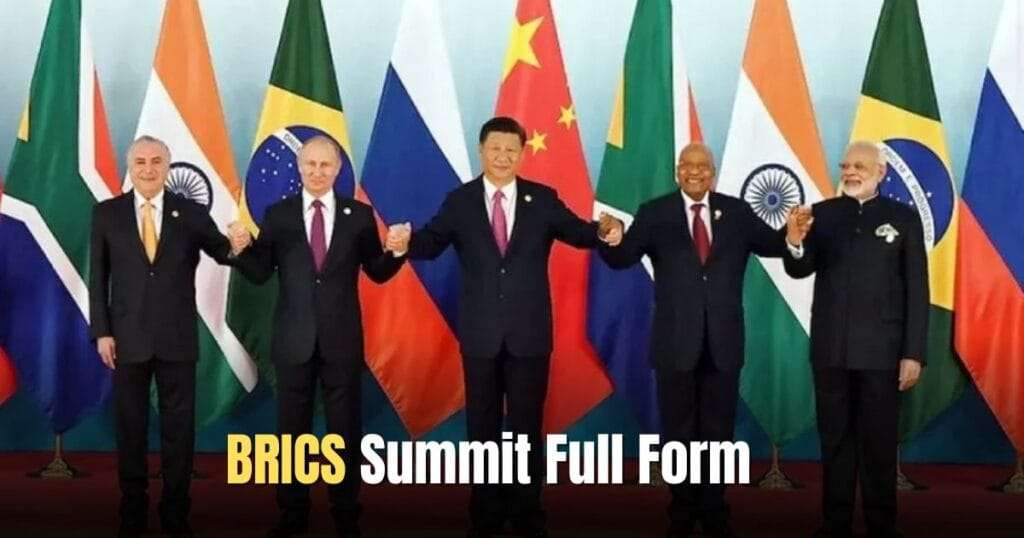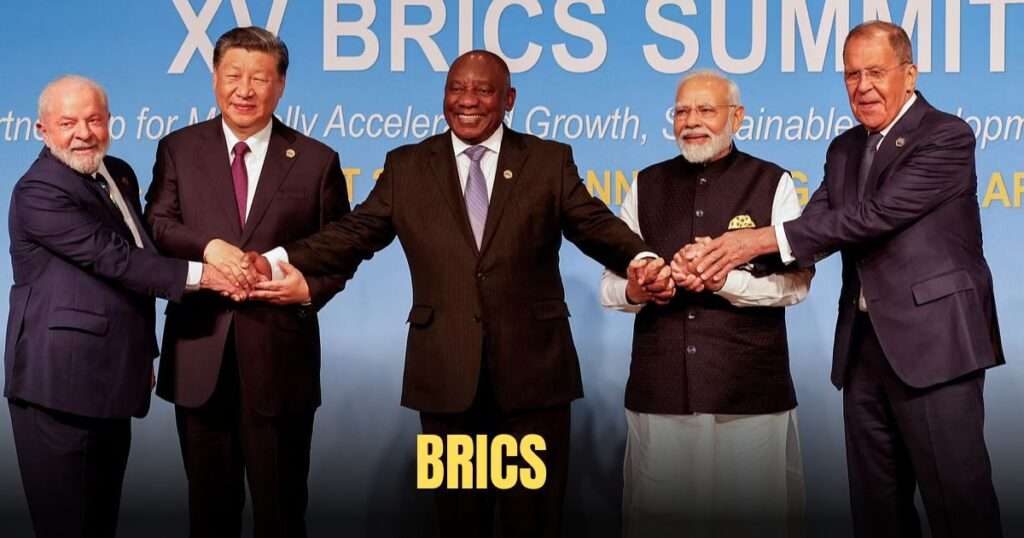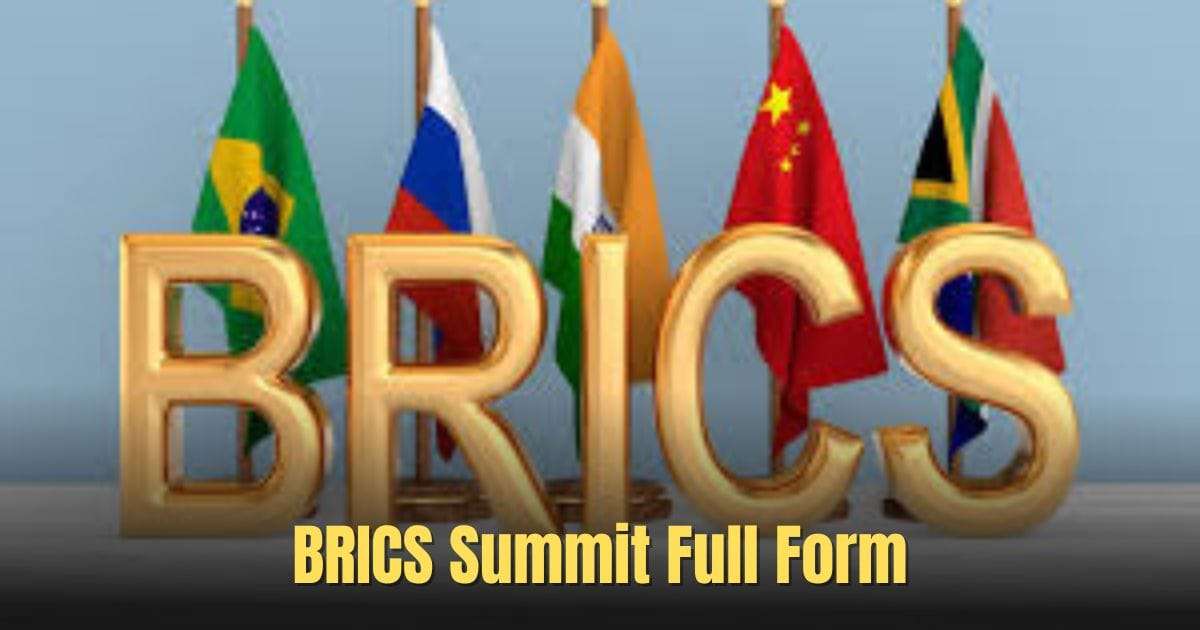BRICS Summit Full Form:The BRICS Summit is indeed a very important contemporary event in the world scene where five of the largest and fastest-growing economies meet.

To help you, the full form of BRICS stands for Brazil, Russia, India, China, and South Africa.
Being basically a coalition that seeks to strengthen cooperation in sectors like trade, infrastructure, and
development, these nations have vast influence in the global economic and political forums. What is the BRICS Summit? And what makes it so important?
This article unfolds everything you should know about the BRICS Summit, covering the list of BRICS countries and delving into their collective role on the world map.
Contents
What is the Full Form of BRICS?
The term BRICS is an acronym for the five member countries:
Brazil
Russia
India
China
South Africa
The BRICS nations formally joined in 2009 with South Africa being admitted as a member in 2010. This bloc aims to attain peace and security and global development as well.
Cultures and economics among BRICS nations are different from each other, but this bound them in one common goal: reforming global governance in a manner that will make it more inclusive and representative for the developing nations.
In this article, we’ll break down everything you need to know about the BRICS Summit, explore the BRICS countries list, and delve into their collective role on the world stage.
What Is the Full Form of BRICS?
The term BRICS is an acronym representing the five member countries:
- Brazil
- Russia
- India
- China
- South Africa
These nations came together formally in 2009 (with South Africa joining in 2010) to create a bloc that aims to promote peace, security, and development globally.
The BRICS nations have diverse cultures and economies, yet they share a common goal of reforming global governance to make it more inclusive and representative of developing countries.
The Origins of BRICS
The idea of BRICS first emerged in 2001 when economist Jim O’Neill coined the term “BRIC” to highlight the rapid economic growth of Brazil, Russia, India, and China.
These nations were seen as potential leaders in reshaping global economic order due to their emerging markets and growing influence.
In 2010, South Africa was officially invited to join the group, turning BRIC into BRICS. The addition of South Africa was a strategic move to include an African voice in this emerging bloc, further solidifying BRICS’ role as a key player in global affairs.
What Happens at the BRICS Summit?
The BRICS Summit is an annual event where the heads of the five member states meet to discuss strategies for cooperation and development. The discussions typically revolve around several key areas:
- Economic Growth: How the BRICS nations can collaborate to boost trade and investment among themselves.
- Sustainable Development: Addressing issues like climate change, poverty reduction, and energy sustainability.
- Reforming Global Governance: The bloc seeks to reform institutions like the United Nations and the International Monetary Fund (IMF) to make them more representative of the current global landscape.
- Technology and Innovation: Emphasizing collaboration in areas like artificial intelligence, fintech, and biotechnology.
The summit provides a platform for these nations to assert their influence on global issues while fostering closer cooperation among themselves.
Also Read:Kotakinozomu-neowase-The Perfect Blend of Tradition and Modern Innovation
BRICS Countries List: A Closer Look at Each Member
Let’s dive deeper into the BRICS countries list to understand each nation’s contribution to the bloc.
1. Brazil
As the largest country in South America, Brazil is known for its vast natural resources, especially in agriculture and energy. It plays a significant role in the global supply of commodities like coffee, sugar, and soybeans.
Brazil’s economy is driven by exports and its participation in BRICS helps it access new markets and investment opportunities.
2. Russia
Russia is a major player in global energy markets, thanks to its vast reserves of oil and natural gas. It also has a strong military presence and is one of the world’s largest arms exporters.
Within BRICS, Russia aims to strengthen its economic ties with other member states and diversify its economy beyond energy exports.
3. India
India is the world’s most populous democracy and has one of the fastest-growing economies. It is a global hub for information technology and boasts a booming pharmaceutical industry.
India’s participation in BRICS enables it to secure investment in infrastructure projects and collaborate in technology and innovation.
4. China
China, the second-largest economy globally, is the manufacturing hub of the world. Its Belt and Road Initiative (BRI) aims to enhance global trade through infrastructure development across Asia, Europe, and Africa.
China’s role in BRICS is vital, given its economic might and technological advancements.
5. South Africa
South Africa is the smallest economy in BRICS but plays an important role as the voice of Africa in the bloc. It has a wealth of mineral resources and serves as a gateway for BRICS nations to tap into African markets.
South Africa’s membership provides the bloc with a crucial link to the African continent, allowing it to engage with emerging markets across Africa.
Why Is the BRICS Summit Important?
The BRICS Summit is more than just a diplomatic meeting; it is a significant platform for these nations to challenge the dominance of Western economic and political models.

Together, the BRICS nations represent about 40% of the world’s population and roughly 25% of global GDP. This economic heft gives them the power to push for reforms in global governance structures.
The bloc’s emphasis on developing a multipolar world order where power is more evenly distributed among different nations has been a key focus.
The BRICS nations also work on creating alternative financial institutions like the New Development Bank (NDB), which funds infrastructure projects in developing countries, and
the Contingent Reserve Arrangement (CRA), which aims to provide liquidity to member countries facing financial difficulties.
Challenges Facing BRICS
Despite its potential, BRICS faces several challenges:
- Economic Disparities: The economies of the BRICS nations vary significantly in size and structure, which can lead to conflicts of interest.
- Geopolitical Tensions: Russia and China’s strained relations with Western powers often create diplomatic hurdles that affect BRICS unity.
- Coordination Difficulties: With five nations having diverse political systems and governance models, coordinating policies across BRICS can be complicated.
However, the bloc continues to evolve and seek common ground on global issues, which is key to its future success.
The Future of BRICS
Looking ahead, the future of BRICS will depend on how effectively the group can collaborate on shared goals. Economic cooperation, investment in infrastructure, and the development of alternative financial systems will remain priorities. Moreover, BRICS’ ability to navigate geopolitical challenges and maintain its relevance on the world stage will determine its long-term impact.
Conclusion
The BRICS Summit plays a vital role in shaping global economic and political policies. The bloc, consisting of Brazil, Russia, India, China, and South Africa, represents a powerful force in the international arena.
Their collective efforts to reform global governance, promote economic growth, and address global challenges underscore the significance of BRICS in today’s world.
FAQs By BRICS Summit Full Form
1. What is the full form of BRICS?
BRICS stands for Brazil, Russia, India, China, and South Africa—a group of emerging economies aiming to reshape global governance.
2. What is the purpose of the BRICS Summit?
The summit serves as a platform for the five member nations to collaborate on issues like economic growth, sustainable development, and global governance reforms.
3. When did South Africa join BRICS?
South Africa became a member of BRICS in 2010, expanding the group from BRIC to BRICS.
4. What is the New Development Bank (NDB)?
The NDB is a financial institution established by BRICS to fund infrastructure projects in developing countries.
5. How do BRICS countries collaborate?
BRICS nations collaborate on various initiatives, including trade, technology, infrastructure, and global governance reforms.



Pingback: What Time Does BO6 Come Out?
When you for the Airport North east of garlic and gangs Rob the enemy is